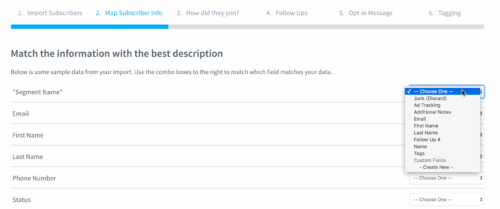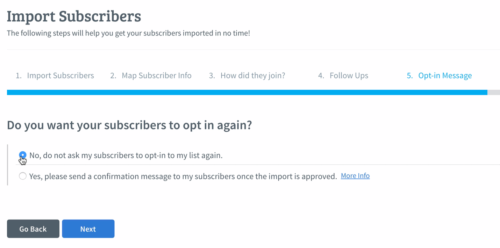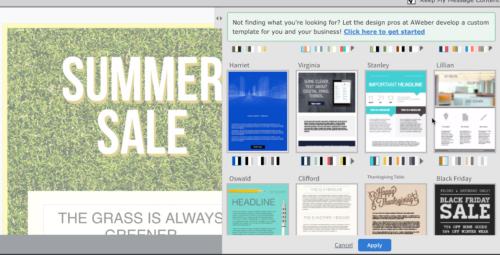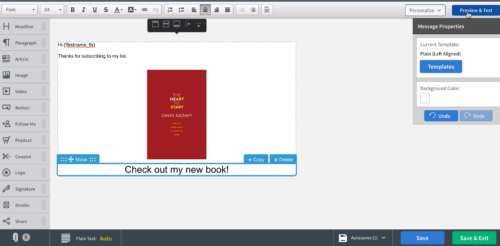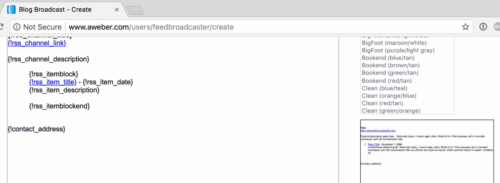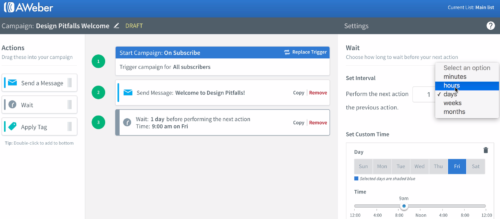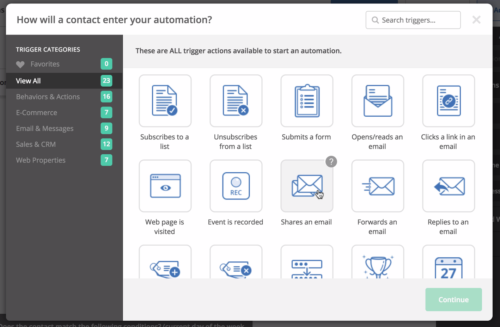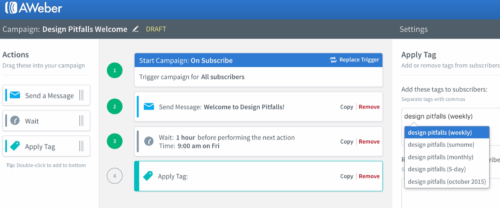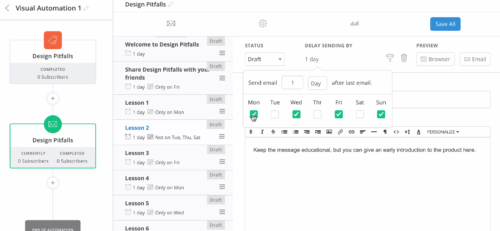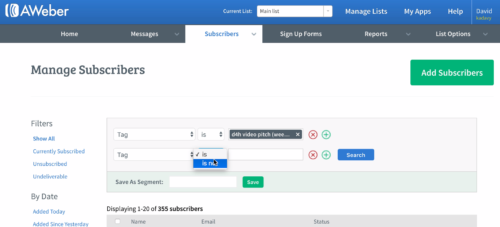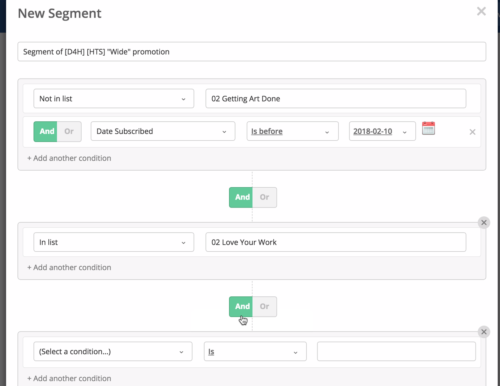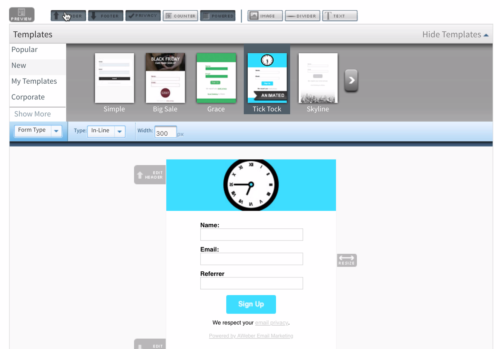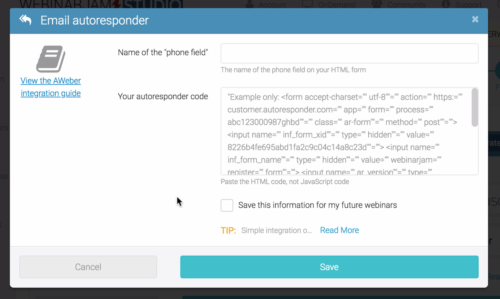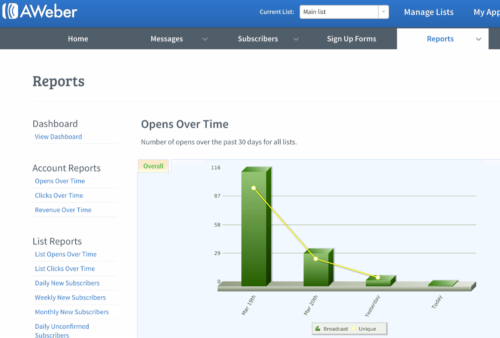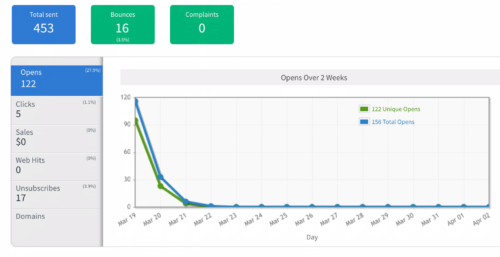Subscribe to blog updates via email »
AWeber vs ActiveCampaign
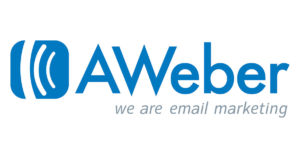 You’re choosing your email marketing platform, and you’re considering AWeber. In this AWeber review, I’ll help you decide if AWeber is right for you and your business. I’ll also compare AWeber with some alternative email marketing platforms, specifically, I’ll compare AWeber vs ActiveCampaign, ConvertKit, and MailChimp.
You’re choosing your email marketing platform, and you’re considering AWeber. In this AWeber review, I’ll help you decide if AWeber is right for you and your business. I’ll also compare AWeber with some alternative email marketing platforms, specifically, I’ll compare AWeber vs ActiveCampaign, ConvertKit, and MailChimp.
My quick recommendations: AWeber vs. ActiveCampaign, ConvertKit, & MailChimp
AWeber is the right email marketing platform for you if all of this applies to you:
- You want simple automation building and email creation.
- You have 5,000+ subscribers, and price is important to you.
- You want tons of integration options.
AWeber is not right for you if these apply to you:

WANT TO WRITE A BOOK?
Download your FREE copy of How to Write a Book »
(for a limited time)
- You want really sophisticated automations.
- You want really beautiful templates.
If you want really sophisticated automations, choose ActiveCampaign. You can start with an ActiveCampaign free trail coupon, or learn more in my ActiveCampaign review (ActiveCampaign is what I personally use).
If you want beautiful templates, choose MailChimp.
If you want a combination of ease of use, and solid automations, but don’t mind sending very simple emails, go with ConvertKit.
AWeber 30-Day free trial
At any time, if you decide AWeber is right for you, or if you just want to try it, I have a 30-day free trial just for you.
Get a 30-day free trial of AWeber »
By the way, this is an affiliate link. I will earn money if you sign up for AWeber through this link, or links to any other service in this AWeber review. As you’ll see, this won’t affect what I say about AWeber.
Pricing of AWeber vs ActiveCampaign & AWeber alternatives
Let’s quickly talk about pricing. Really, I recommend that you don’t make your email marketing platform decision based upon price. You don’t typically see a huge difference in pricing between platforms, and if you’re an active email marketer you can make up any price differences by having the platform that works for your business and makes you more money.
AWeber Alternatives Pricing
| # of Subscribers | 500 | 1,000 | 5,000 | 10,000 | 25,000 |
|---|---|---|---|---|---|
| ActiveCampaign (Lite) 14-day free trial » | $15 | $29 | $89 | $139 | $225 |
| AWeber 30-day free trial » | $19 | $29 | $49 | $69 | $149 |
| ConvertKit 14-day free trial » | $29 | $29 | $79 | $119 | $199 |
| MailChimp 2,000 contacts free » | FREE | FREE | $50 | $75 | $150 |
| All prices on per month basis. | |||||
AWeber starts beating other services once you have about 5,000 contacts. MailChimp can be tempting when you have a smaller list. They’re free for up to 2,000.
I think MailChimp is a good choice if you just want something simple to send out email blasts, but if you’re serious about your email marketing efforts and want sophisticated automations and segmenting, I’d recommend going with ActiveCampaign or ConvertKit. AWeber does have an easier-to-use and slightly more powerful automation builder than MailChimp does, so if you’re looking for something in between, AWeber might be a good choice.
Switching email marketing platforms can be a lot of work, so it’s best to get it right the first time. I’d caution against going with MailChimp just because its free if you’re just starting out.
Now that you’ve read about some AWeber alternatives, let’s get on with the AWeber review.
A tour and review of AWeber’s features
Import subscribers into AWeber
If you already have an email list for your business, you’ll need to import your existing contacts. This is easy to do. You can copy and paste or enter by hand. Or, you can import your subscribers from a file.
Here I have a CSV of some subscribers, and I can choose which fields go with which, including tags. If the right field doesn’t exist in my AWeber account, I can add a custom field.
I let them know where I got the emails, and do I want them to get my existing auto-responder? They call it a follow-up series.
Do I want them to opt-in once again? This is good that they give you the choice because I think they used to require everyone you imported to opt-in again.
Finally, I can add additional tags to remind me which import they came in from. And, my contacts are importing.
Compose a Broadcast on AWeber
Next up, we’ll do a basic email. AWeber calls this a “Broadcast.”
I can do plain text, with ugly links and all. I can do an HTML editor. Or, I can use AWeber’s drag and drop email builder, which is what I’ll do.
Here I’ve defaulted to one of AWeber’s templates. You can see they have lots of template. My opinion as someone who helps people learn web design is that these templates are extremely dated and not very attractive. Again, I think MailChimp has the most attractive templates.
But, I don’t like to send complicated emails with templates. As a designer, I don’t like AWeber’s templates, but as an author, I want my emails to look as plain as possible – just like if they were getting an email from a friend.
I can write my text in here. I can add an image. But to add an image in the middle of text I have to create multiple text boxes. I find that experience clunky, though ActiveCampaign‘s drag and drop editor is similar. I do like that AWeber’s emails are responsive, so whether on desktop or mobile the formatting looks good.
MailChimp’s drag and drop makes it the easiest email editing experience
MailChimp has the easiest editor – you can drag images directly into your library and insert them in your email.
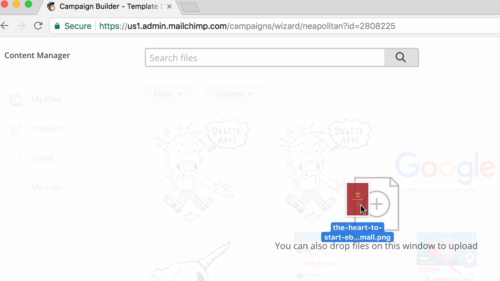
Dropping an image file onto MailChimp’s editor
Create a Blog Broadcast on AWeber
Next up, you can create a blog broadcast. You can enter the RSS feed of your blog, and AWeber will automatically send an email whenever you publish.
You can edit some simple code to change what shows up where.
Creating a “Campaign” automation on AWeber
Next up, my personal favorite: Automations. AWeber calls their automations “Campaigns.”
I’ll see what it’s like to recreate my free email course, Design Pitfalls. I’ll make a welcome Campaign. I’ll activate it when they subscribe.
- There are actions I can use to build my automation. You can see that the options are extremely limited.
- I can apply a “wait.” My email course starts each Monday, so in my welcome sequence, I like to send an email on Fridays to get my students pumped up for the course.
- I’ll only allow it to send on Fridays. I’ll delay the email only one hour, in case someone signs up on a Friday, they’ll usually still get the email.
By comparison, ActiveCampaign has way more options on their “Lite” plan. Even more with their more advanced plans. But, AWeber, vs ActiveCampaign’s automation builder, is more simple, and more nimble.
Adding a Tag in an AWeber Campaign
I can then add a tag that will activate the “Design Pitfalls” campaign, which is the course itself. I want the first lesson to go out on Mondays and the second lesson on Wednesdays.
When the course is over, I could add another tag to start another campaign and pitch my premium course. I can also add what AWeber calls an “automation.” If a contact clicks a link in a given email, I can trigger that to add a tag, which could trigger another campaign.
ConvertKit’s automation builder is easy to use & extensive
By the way, ConvertKit has a great combination of an easy-to-use automation builder, with a healthy set of options for building those automations. You can check it out for yourself with my ConvertKit free trial.
Create a segment on AWeber
If you want to send an email to a select group of subscribers, you want to search your subscribers, and create a segment.
You can search by tag, or any other field you’ve created. You can combine search attributes. However, one limitation is you can only search by AND, as it has this tag for having gone through my course AND does not have this other tag for having become a customer.
You can’t search by say, has this tag for this course OR this tag for this other course, AND does not have this other customer tag.
ActiveCampaign, vs AWeber, has richer segmentation options
Limited segmentation options was one big reason I switched from MailChimp to ActiveCampaign. With ActiveCampaign, you can build extremely complex segments, with multiple ANDs and ORs.
AWeber’s Sign Up forms
Next up, creating a sign up form for new subscribers. AWeber has templates for this. Again, I think they’re pretty dated. You can add an image and change colors. I sign up through one of these forms, I’ll get a confirmation email. AWeber has double opt-in by default, but you can turn it off.
AWeber Thank You Pages
I can customize AWeber’s “thank you” page with just a logo. I can also add a so-called “Smart” Video thank you page, which is just a video embedded that shows subscribers how to confirm their email. It’s in Flash, so I couldn’t even see it in the Chrome browser I normally use. Very dated. Or, you can simply add a custom page by entering a URL.
Global Text Snippets on AWeber will save you a ton of time
AWeber has one very cool feature: Global text snippets. You can make little variables that you can use throughout all of your emails. If you have a coupon code that you want to change out periodically, you can change it here once, and it will change across all emails where you’re using that variable. This will save you a ton of time.
ActiveCampaign has a similar feature called “message variables,” which I use frequently, and which would be a good reason to not switch to ConvertKit. It makes it so that I can run something like a webinar sequence, and simply change out variables for dates and times and coupon codes.
AWeber has tons of integrations
One of the best things about AWeber is that they’re so popular, and have been around for twenty years. They integrate with just about any service you might use.
When you’re deciding on an email marketing platform, be sure to check just how well a given platform integrates with other services you count on.
AWeber, vs ActiveCampaign’s, WebinarJam integration is limited
ActiveCampaign has rich integration with WebinarJam
An integration I count on is WebinarJam. I can see that WebinarJam’s integration with AWeber is pretty limited. It’s some code I can use to make a sign-up form.
By contrast, ActiveCampaign‘s integration with WebinarJam is very detailed. I can add tags based upon whether someone attended my webinar, or by how long they stayed. These tags can then trigger automations. I can automatically send one sequence to people who attended the webinar, and a different sequence to people who missed it. I’d have to do this manually with AWeber, or with MailChimp or ConvertKit for that matter.
AWeber reporting
Naturally, you want to know how your email marketing efforts are paying off. For this, let’s review AWeber’s reporting. You can look at numbers across your list, such as opens over time, clicks, revenue, and subscriber growth.
You can insert some Javascript on your website to integrate your analytics. You can then set up goals based upon pages visited, and assign revenue to those page visits to track earnings from your email marketing.
AWeber Broadcast reporting
Seeing the money earned in sales from the broadcast is nice if you have that level of control over your payment processing. It wouldn’t be terribly straightforward in all cases to get accurate numbers there.
Conclusion
In conclusion, AWeber is a solid email marketing platform if you want simplicity, a good price above 5,000 subscribers, and if you want basic and easy-to-build automations. AWeber also has tons of integrations.
If AWeber looks good to you, get their 30-day free trial.
Get a 30-day AWeber free trial »
AWeber Alternatives
If you want more attractive templates, but don’t mind not having tagging, go with MailChimp.
If you want more sophisticated automations, and the chance to upgrade to a CRM and/or SMS marketing, go with ActiveCampaign.
If you want quick and easy automations, and don’t mind being limited to plain emails with the occasional image embedded, go with ConvertKit.

